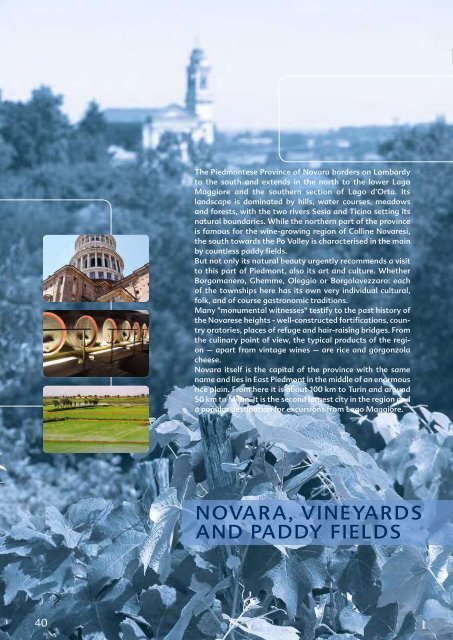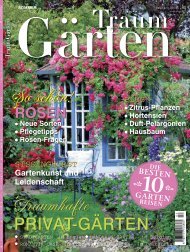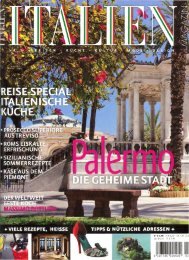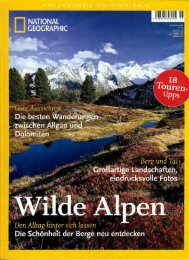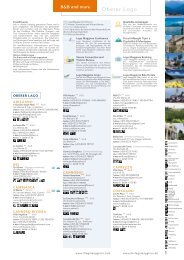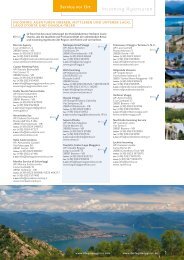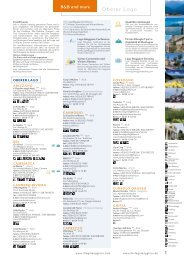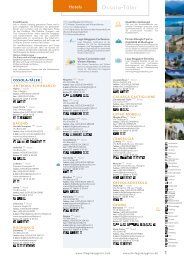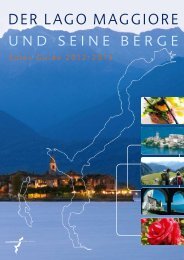And SurroundinG MountainS - Lago Maggiore
And SurroundinG MountainS - Lago Maggiore
And SurroundinG MountainS - Lago Maggiore
Create successful ePaper yourself
Turn your PDF publications into a flip-book with our unique Google optimized e-Paper software.
40<br />
The Piedmontese Province of Novara borders on Lombardy<br />
to the south and extends in the north to the lower <strong>Lago</strong><br />
<strong>Maggiore</strong> and the southern section of <strong>Lago</strong> d’Orta. Its<br />
landscape is dominated by hills, water courses, meadows<br />
and forests, with the two rivers Sesia and Ticino setting its<br />
natural boundaries. While the northern part of the province<br />
is famous for the wine-growing region of Colline Novaresi,<br />
the south towards the Po Valley is characterised in the main<br />
by countless paddy fields.<br />
But not only its natural beauty urgently recommends a visit<br />
to this part of Piedmont, also its art and culture. Whether<br />
Borgomanero, Ghemme, Oleggio or Borgolavezzaro: each<br />
of the townships here has its own very individual cultural,<br />
folk, and of course gastronomic traditions.<br />
Many "monumental witnesses" testify to the past history of<br />
the Novarese heights - well-constructed fortifications, country<br />
oratories, places of refuge and hair-raising bridges. From<br />
the culinary point of view, the typical products of the region<br />
– apart from vintage wines – are rice and gorgonzola<br />
cheese.<br />
Novara itself is the capital of the province with the same<br />
name and lies in East Piedmont in the middle of an enormous<br />
rice plain. From here it is about 100 km to Turin and around<br />
50 km to Milan. It is the second largest city in the region and<br />
a popular destination for excursions from <strong>Lago</strong> <strong>Maggiore</strong>.<br />
NOVARA, VINEyARDS<br />
AND PADDy FIELDS<br />
the VineyarDs<br />
Borgomanero<br />
altitude 307 m<br />
Population 19315<br />
Market day Friday<br />
Tourist information<br />
Corso Roma 136<br />
28021 Borgomanero - NO<br />
telephone (+39) 0322 869992<br />
Fax (+39) 0322 831014<br />
e-mail uffturistico@comune.borgomanero.no.it<br />
www. comune.borgomanero.no.it<br />
Museo Etnografico di Santa Cristina<br />
Ethnographic Museum<br />
ex Palazzo Bono, Piazzale Chiesa 1<br />
Fraz. Santa Cristina<br />
telephone (+39) 0322 837711<br />
e-mail museo@santacristinanostra.it<br />
www.santacristinanostra.it<br />
Ghemme<br />
altitude 240 m<br />
Population 3668<br />
Market day Thursday<br />
Tourist information<br />
IAT Ghemme<br />
Via Interno Castello 1<br />
28074 Ghemme - NO<br />
telephone +Fax (+39) 0163 841870<br />
e-mail info@ghemme.net<br />
www.ghemme.net<br />
www.collinenovaresi.it<br />
Novara, Vineyards<br />
and Paddy Fields<br />
Romagnano Sesia<br />
altitude 265 m<br />
Population 4308<br />
Market day Saturday<br />
Museo storico etnografico della<br />
Bassa Valsesia<br />
Ethnographic Museum<br />
Viale Antonelli 1<br />
28078 Romagnano Sesia - NO<br />
telephone + Fax (+39) 0163 827237<br />
e-mail info@museostoricoromagnano.it<br />
www.museostoricoromagnano.it<br />
Opening times<br />
Saturday and Sunday 2.30 pm to 6.30 pm<br />
Oleggio<br />
altitude 232m<br />
Population 13.405<br />
Market day Monday and Friday<br />
Museo Civico Etnografico “Fanchini”<br />
Ethnographic Museum<br />
Vicolo Chiesa 3<br />
28047 Oleggio<br />
telephone + Fax (+39) 0321 91429<br />
e-mail culturasport@comune.oleggio.no.it<br />
www.comune.oleggio.no.it<br />
Admission free<br />
Ferrovie dello Stato (in the four cities)<br />
Italian Railways<br />
www.trenitalia.it<br />
www.turismonovara.it<br />
Sightseeing<br />
The heart of the Province of Novara stretches out between the lowest tip of <strong>Lago</strong> <strong>Maggiore</strong> in<br />
the north and the flat paddy fields in the south. The so-called Alta Pianura is thickly populated<br />
and, contrary to its name, is anything other than flat. Besides the two main rivers Sesia and<br />
Ticino, there are many other water courses permeating the region and spreading out over<br />
sloping terraces formed in the Ice Age. The vine has been cultivated for millennia on the gentle<br />
hills of the Colline Novaresi, with grape varieties such as Nebbiolo, Vespolina and Bonarda.<br />
Today the region boasts a great number of wineries, welcoming visitors to taste its choice and<br />
vintage wines and as a delicious extra to savour its other local products.<br />
Borgomanero<br />
Borgomanero was founded by the Novarese people in 1194 with a location to the north of their<br />
own township as a kind of fortress playing a strategic role. When the building was finished in<br />
the early thirteenth century, it received its name of Borgo Mainerio in honour of the city bailiff<br />
of Novara, Jacopo Mainerio. Today, Borgomanero is a flourishing centre of trade and industry,<br />
yet it has preserved its historical and artistic attractions. Piazza Martiri is the actual town<br />
centre where the façade of the Collegiate Church of San Bartolomeo (12th century) is of<br />
exceptional interest. Inside there is a wonderful triptych, dating from 1566, frescoes and paintings<br />
by Morazzone, and a magnificent baroque wooden altar. The Oratory of San Leonardo<br />
with its beautiful frescoes dating from the thirteenth century is the oldest church in the town<br />
(11th/12th century). The façade and the supporting columns are made of great ashlars, while<br />
the side walls and apse were built of gravel. Additional rewarding sights await the visitor: the<br />
Corso Roma, where a market is held every Friday, as has been the custom for five hundred<br />
years, the Palazzo d'Este, an old residence from the fifteenth century; a medieval bridge called<br />
“del Torrione”, the palace of Vergano from the fourteenth century and the Oratory of San<br />
Nicola alla Baraggiola, a rustic, pre-Romanesque building with a stone bell tower. West of<br />
Borgomanero surrounded by woodland and vineyards is the picturesque villages of Maggiora<br />
and Boca, the latter well-known and beloved for its wine. Set off somewhat from the village<br />
we see the monumental pilgrimage church del Crocifisso rising up, a work of the renowned<br />
architect Alessandro Antonelli (completed in 1917), and the fortress of Mantalbano where are<br />
still some interesting frescoes to be seen. East of Borgomanero is the village of Gattico in beautiful<br />
and exceptionally diverse countryside. It is a region of much Romanesque architecture,<br />
including the ruins of the Basilica San Martino and many other churches. Near the road from<br />
Borgomanero to Gattico you shouldn't miss seeing the splendid, seventeenth-century Villa<br />
Leonardi and its English garden, and the Oratory della Madonna di Campagna. Moreover,<br />
further East from Borgomanero, by the village of Comignago, the Nature Reserve of <strong>Lago</strong>ni di<br />
Mercurago and its late roman Necropolis is well worth a visit.<br />
Vineyard<br />
Borgomanero Collegiata San Bartolomeo<br />
Boca<br />
www.illagomaggiore.com<br />
General<br />
Information<br />
Upper, Central,<br />
Lower<br />
<strong>Lago</strong> <strong>Maggiore</strong><br />
East Shore<br />
and Varese<br />
The Swiss part<br />
of the Lake<br />
Ossola Valleys<br />
Lake Orta<br />
Novara,<br />
Vineyards and<br />
Paddy Fields<br />
Hotels<br />
Local Services<br />
41


